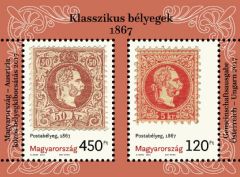
Magyarország- Ausztria közös kisív megjelenés, az első magyar bélyegkibocsátás 150. évfordulója alkalmából!
A Magyar Posta az első magyar bélyegkibocsátás 150. évfordulójáról magyar–osztrák közös kibocsátású alkalmi bélyegkisívvel is megemlékezik. A kisív Anita Kern grafikusművész tervei alapján az ANY Biztonsági Nyomdában készült 60 000 példányban. A kisív augusztus 25-től kapható

Az 1867-es év fordulópontot jelentett a magyar állam és a magyarországi postaszolgálat történetében. Ebben az évben az 1848-as szabadságharcot követő passzív rezisztencia és a Habsburg Birodalom számára kedvezőtlenül alakuló nemzetközi események hatására Magyarország államisága a kiegyezéssel és az osztrák császár, I. Ferenc József magyar királlyá koronázásával ismét helyreállt. Létrejött az Osztrák–Magyar Monarchia, amivel kezdetét vette a dualizmusnak nevezett, egészen 1918-ig terjedő korszak, amely máig a magyar történelem egyik legvirágzóbb, legprosperálóbb időszakának tekinthető.
A postára vonatkozó egyezmény szerint az osztrák és magyar postaigazgatás különvált, az így létrejött önálló magyar igazgatás egyik első intézkedése a saját postabélyegek megrendelése és használatba vétele volt. Az 1867. június 1-jén kibocsátott első bélyegek azonban csak kompromisszumok árán valósulhattak meg, mert az ország területén nem volt olyan nyomda, ami teljesíteni tudta volna a megfelelő minőségű és példányszámú postai értékcikkek előállításához szükséges feltételeket, így a gyártás a bécsi Császári és Királyi Udvari és Államnyomdában történt. A 7 címletből álló, Ferenc József-portrét ábrázoló sorozat 2, 3, 5, 10 és 15 krajcár névértékű címletei június 1-jén, a 25 és 50 krajcár névértékű bélyegek pedig szeptember 1-jén jelentek meg.
Hosszú ideig vita tárgya volt az a kérdés, hogy ez a kiadás tekinthető-e az első magyar bélyegnek. Idővel és pénzzel történő takarékosságra hivatkozva ugyanis az Osztrák Posta saját hatáskörben ugyanezzel a bélyegképpel a Monarchia többi országában szintén forgalomba hozta a sorozatot, így állt elő az a különös helyzet, hogy két önálló postaigazgatás ugyanazon rajzú bélyegeket használta. Napjainkra egyértelműen elfogadott, hogy azok a példányok, amelyeket bizonyíthatóan Magyarország területén használtak fel – azaz magyar postabélyegzővel érvénytelenítettek – magyar bélyegek.
Az 1867-es kiadás egészen 1871-ig, az új, immáron a Magyarországon gyártott bélyegek megjelenéséig forgalomban maradt, azonban Ausztriában és csatolt területein továbbra is ezt használták bérmentesítésre, amiből következően az érintett területeken a magyarországi igényekhez képest jóval nagyobb példányszámban használták fel őket. A bélyegeket durva nyomású, majd később finom nyomású változatban is kiadták – Magyarországon kizárólag a durva nyomású példányok kerültek forgalomba.
A közös bélyegen az 1867-es kiadás durva nyomású, 50 és 5 krajcáros címletei jelennek meg, a kisív keretén az 5 krajcáros bélyeg háttérmotívumának felhasználásával készült rajzolatokkal. Az elsőnapi borítékon az eredeti bélyegsorból készült montázs látható, az alkalmi bélyegző szintén az 5 krajcáros címlet grafikai elemeinek felhasználásával készült. A magyar és az osztrák kisívet, továbbá az alkalmi bélyegzők lenyomatát tartalmazó, A5-ös méretű emléklapon magyar és német nyelvű leírás is olvasható.
Forrás: Posta
Hungary – Austria joint stamp issue
Hungary Post is marking the issue of the first Hungarian postage stamp by a Hungarian-Austrian joint issue of a commemorative miniature sheet. Sixty thousand copies of the miniature sheet designed by the graphic artist Anita Kern were produced by ANY Security Printing Company.

1867 was a historic turning point for both the state of Hungary and the Hungarian postal service. In the wake of the passive resistance after the 1848 War of Independence and due to the effect of unfavourable international events for the Habsburg Empire, this was the year when a compromise was reached to restore Hungarian statehood and the Austrian Emperor Franz Joseph I was crowned King of Hungary. Austria-Hungary was created. This was known from its inception until the end of the period in 1918 as the dual monarchy and was one of the times in Hungarian history when the country flourished and prospered to the greatest extent.
Under an agreement for the post, the postal services of Hungary and Austria separated, and one of the first measures of the newly independent Hungarian postal service was to order and bring into use its own postage stamps. However, compromises had to be made in order to issue the first stamps on 1 June 1867 because there was no print works in Hungarian territory that was equipped to produce postage stamps of the required quality and quantity. For this reason they were produced at the Imperial and Royal Stationery Office in Vienna. Of the series of seven stamps bearing the portrait of Franz Joseph, the 2, 3, 5, 10 and 15 krajcár denominations were released on 1 June and the 25 and 50 krajcár stamps on 1 September.
For a long time whether these stamps were the first Hungarian stamps was the subject of debate as, on the grounds of saving time and money, the Austrian Post at its own discretion circulated this series with the same design in the other countries of Austria-Hungary as well. In this way the strange situation evolved where two separate postal administrations used stamps with the same design. Nowadays it is clearly accepted that those stamps which were demonstrably used in Hungarian territory, in other words were cancelled with Hungarian postmarks, are Hungarian stamps.
The 1867 issue remained in use until 1871 when new postage stamps that were produced in Hungary appeared. However, in Austria and areas annexed to it, the 1867 stamps continued to be used to pay for postage and, as a result, they were used in far greater numbers in the affected areas than in Hungary. The stamps were printed initially by a crude technique and later an improved version was issued. In Hungary only the earlier crude stamps were circulated.
The crudely printed 1867 edition of the 50 and 5 krajcár stamps appear in the joint issue and the background motif of the 5 krajcár stamp has been used for the border decoration. On the first day cover there is a montage of the original stamp series, and the graphic elements of the 5 krajcár stamp are also used for the special postmark. The Hungarian and Austrian miniature sheets and impressions of the special postmarks appear together with descriptions in Hungarian and German on the A5 commemorative card.
Source: Post










